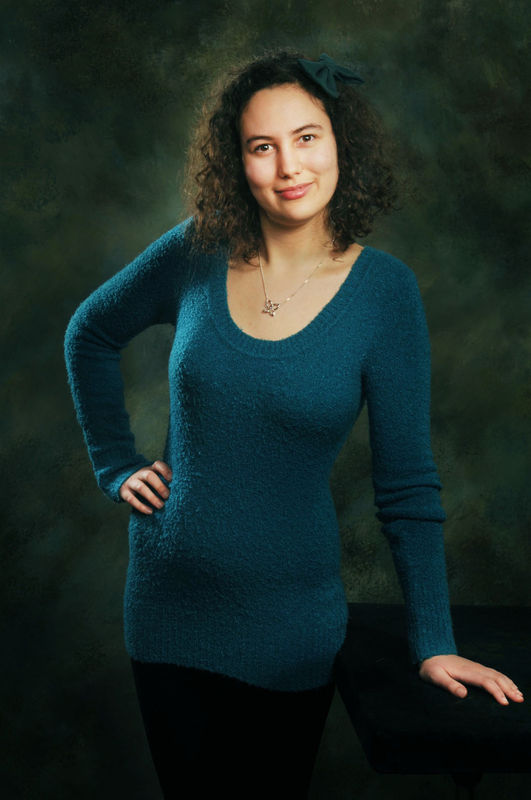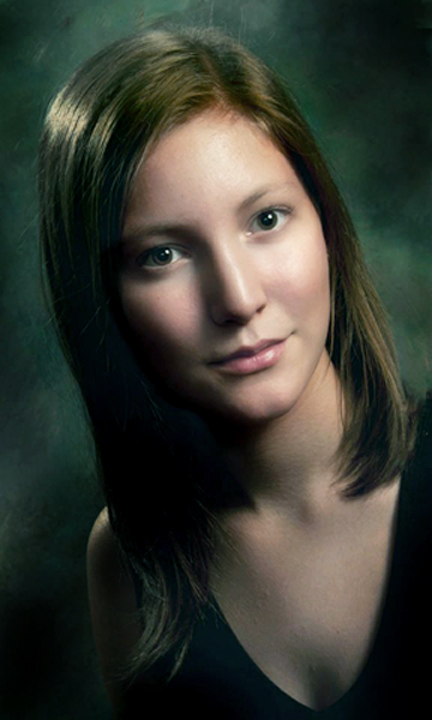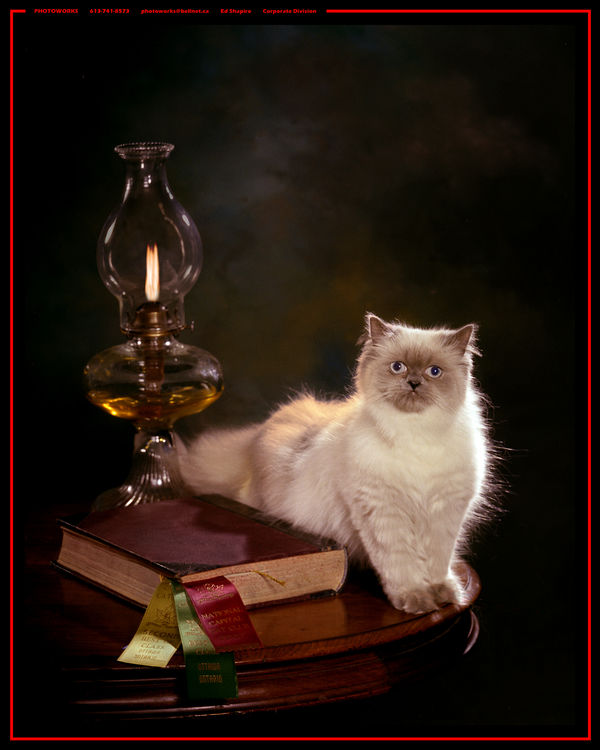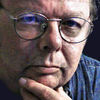E.L.. Shapiro wrote:
Here's another piece from my archives that may prove useful to regular or potential flash equipment users.
Bounce Lighting
A tutorial article by Ed Shapiro
One of my all time favorite cartoons appeared in Popular Photography Magazine back in the early 1960s. The sketch showed a photography student standing over what was left of a totally destroyed and smoldering electronic flash unit with his teacher looking on in horror. The caption read
well YOU told me to bounce the strobe off the ceiling.
Well, I guess the young student didnt understand his teachers instructions, to put it mildly. Well, that was well over 40 years ago but nowadays, I often wonder if the concept of bounce lighting is totally understood. Not that anyone is gonna take their overly priced auto-everything speed-light and toss it up at the ceiling anytime soon, especially seeing that the flash unit is permanently bolted down to the camera, in which case the camera would be destroyed as well. OK- Sorry for the sarcasm.
First lets define bounce lighting. What we are doing when we use bounce or indirect lighting, is rather than aiming our main light source directly at the subject we are aiming it at another surface which, hopefully, will redirect the light toward the subject in a softer, more natural and broader form. In doing this, we are addressing 2 light sources; the primary source which is the raw light from a flash unit or similar source and the secondary source with is the surface we are now counting on for smoother more natural lighting. The nature of the surface will also have a significant effect on the final image. This means that flat painted walls or reflector panels will have a different effect from that of metallic surfaces such as foils or silver-type cloth flats or umbrellas.
A little history and background: This applies to handheld mobile camera work such as press and photojournalistic photography, wedding and special event coverage where the photographer is a solo act and has limited resources in lighting possibilities and improvisation and different or more improvisational solutions are required than might be less necessary in controlled studio scenarios. The usual situation is a camera equipped with an on-the-camera or shoe mounted flash unit. Direct on-camera flash has suffered a long time bad reputation for such detrimental affects as flat harsh lighting, major light fall off as per the inverse square law thus yielding overexposed foregrounds and black underexposed backgrounds and, of course, those eerie shadows on the walls behind the subjects. The only saving grace and or redeeming factor what with this litany of bad results is that this offending light source is reliable and will usually provide enough even illumination to record an image and with a little more savvy on the photographers part can look decent enough for some purposes.
In days gone by, for many decades, the 4x5 press camera, mainly the Speed Graphic, was indeed that workhorse of the industry and the badge of the professional photographer. First equipped with flash holders for disposable flash lamps and of course, as technology progressed, electronic flash units. Although I cant be sure about who invented the concept of bounce or off-the-camera flash technique, if I had to take a guess, it probably goes back to the creative energy of the press photographers combined with their friends at Graflex the manufacturers of the famed Speed and Crown Graphics. . Perhaps the minor inventions of the coiled flash cords and the quick release flash shoes on those big bulky press cameras went almost unnoticed or just taken for granted but well accepted. Theses flat shoes and nifty encircling clamps enabled the photographer a fast way of getting the flash off the camera to create more depth of lighting, enable the use of light and shadow as opposed to flat lighting and getting the light high enough to throw those nasty alter-ego shadows behind the subject where they could no longer be seen. An electromagnetic solenoid allowed the photographer to release the shutter from a micro switch aboard the flash units handle. Hey- high tech for those days! And then-wow- some daring photographers began to aim that flash unit at the ceiling for a more natural look, a broader coverage and less fall off. After a while, some wedding photographers started to delve into this new and outrageous idea. This is one of the reasons why I think of straight bolted down on camera flash is kind of a digression to the days of non-creative flash technique.
I will never forget the day when I was enjoying a now nostalgic evening at Elbit's Field watching a Brooklyn Dodgers vs. New York Yankee baseball night game. Someone in the stands stood up with his camera with the flash unit aimed up at the sky and tried to capture a play several hundred feet away. I had a good laugh and perhaps some innocent bring on a little-known planet only a few light years away, some day soon, will see an unexpected flash of light and say, what the hell was that! I still see people doing that- CRAZY!
Well- most photographers around here will not do that as described above but many do arbitrarily aim their light at walls and ceilings not really knowing how the method works and end up with unexpectedly disappointing results. Theses photographers go by the theory of what goes up must come down or worse ye,t what I now call the Varner Von Braun theory of the rockets go up and WHO CARES where they come down
Well, we are talking about light now not Dr. Von Brauns infamous V-2 Rockets (potential guided missals) of World War II so no harm will be done except to your photographic results with misused or misconceived bounce light methods.
So
here are the ills and the remedies and a few new/old ideas: The first thing most newcomers to bounce lighting tend to do is to aim the flash unit directly up at the ceiling and this can be deadly for all kinds of portraiture and people pictures. The light will hit the ceiling and rain down on the subject as it would on a hazy or light overcast day. I call this wall washer lighting and what it does is leaves the subjects eyes without illumination and a classic case of raccoon eyes result- dead looking eyes in shadow with no brilliance, shadow detail or sparkling catch-lights. This looks especially bad when the subject(s) is facing the camera. This lighting will also exaggerate skin textures and wrinkles on the faces of your subjects. A pretty bride may get away with this lighting especially if she is well made up, however, the mammas and the papas and the grandparents faces will look like a relief map of the Himalayas. This is great lighting if your local dermatologist asks you for clinical photographs of rashes and skin diseases.
Before going into the remedies, dos and dont for bounce lighting, I would like to talk a little bit about flash equipment. I am usually not hung up on equipment issues and I feel that most of the time photographers can make do with what the have but I have to admit one prejudice. I will never buy a flash unit with a fixed reflector and flash tube design. I prefer the ones with interchangeable reflectors and user changeable flash tubes such as the Lumadyne, Q-Flash and some of the older (J) models made by Sunpack and some older Norman and Ascor units. Being able to change the reflectors, use bare bulb and being able custom make you own reflectors, as well as availing yourself of the variety of versatile reflectors and modifiers made by various manufacturers, puts an entirely improved complexion on the use of on and off camera flash- in many cases it will also put a better complexion on your subjects.
Now that we have my pet flash equipment peeve out of the way and on the table we can go on to the discussion of how to better use bounce flash. When we are using those nice big round parabolic reflectors on the aforementioned flash equipment the lighting will be of softer, more even and feather-able that than other kinds of popular units. If they are used directly without bounce techniques or add-on light modifiers they will yield better results right off the bat as on camera flat light or fill light in a multiple lighting systems. Feathering means using the edge of the beam rather that the hot spot in the center of the beam. This method yields better specular highlights, texture and provides for more evenly distributed light on the face. This method does not work well with square or oblong reflectors for a number of reasons. The linear flash tubes in some of theses units are backed up with very highly polished metallic reflectors or even mirror Mylar to help boost the output power and a plastic lens is used to spread the light somewhat. This does not have the same properties as light from a helical or circular flash tube mounted in a parabolic reflector.
When I want to bounce the light in the most simple manner, I have two choices; I can aim the light directly at the ceiling and use my customized reflector in which I have punched a 1 inch hole in the side of the reflector allowing just enough light out to illuminate the eyes and clean up some of the wrinkled skin. I have another such reflector on which I have riveted a tablespoon and this also throws some of the light forward. This method can also be used with those square and oblong units with the aid of an elastic band or a couple of cable ties.
There is yet another great technique called partial bounce and this is where that round feather-able reflector shines. In this method the light is tilted to the 45 degrees position (not straight up) and some of the light will bounce off the ceiling and some of the light will illuminate the eyes, produce decent textures in such things as wedding gowns and end in a bit of desirable fall of at the bottom of the composition. This can also be done with square or oblong units but not to the same degree of effectiveness. The light that is striking the ceiling will help illuminate the background as well and create a more delicate image with the feeling of space around the subject because the background is not likely to go black.
Obviously, as soon as you remove the reflector you also have at your disposal the wonderful world of bare bulb flash technique, that is omni-directional lighting. In this method, some of the light will directly strike the subject and the rest if strikes the surrounding walls and ceilings and bounces back toward the subject. The effectiveness of this type of lighting depends on the size of the area you are working in and the potential reflectivity of the aforementioned surfaces. With the reflector off or the light bounced as explained above, the average loss of light is about 2 f/stops. This can be an advantage if you want to reduce your depth of field or, in a multiple lighting system you want to be able to reduce your fill light power beyond the scope of you fill flash unit.
Well then- so how do we control our bounce lighting and know where it is going? We can chimp our heads off but in a wedding or a news coverage that is simply not practical- we need to know the basic effect we are getting before we release the shutter and bring home each shot. Even if the is automatic exposure control, there is not automatic control that can adjust the aesthetics of our lighting.
The main theory that is at the root of bounce lighting is the angle of incidence rule, that is, THE AGLE OF INCIDENCE IS EQUAL TO THE ANGLE OF REFLECTANCE. That simply means that the angle at which the light strikes the bounce surface is the angle at which it is reflected from the bounce surface. If you want to experiment with this theory and actually SEE exactly how it works you can do this easily and quickly by the use of a mirror about 16x20 (inches) in size. You can use a simple 75-watt display spotlight in an ordinary clamp-on socket. Aim the light into the mirror at say 45 degrees to the mirrors surface and you will notice when you walk around the room and observe the walls you will notice that the spot of light too is at 45 degrees to the mirrors surface. If you look into the mirror from 45 degrees from the surface at 45 degrees opposite the light source you will see a direct reflection of the light. Thats how we photograph the bride in the mirror- we shoot at an oblique angle and see no bad reflections.
If you know at what angle you are aiming your primary light source, you can easily predict where the light will land. If this landing site is in front or beyond the subject you will not achieve good results.
As a spin-off of the aforementioned experiment another valuable technique arises. I have found myself, on occasion; working is cramped room and offices where it is difficult to place my lights exactly where I want them to be. For the same reason, small rooms, many of them have a mirrored wall or sliding mirrored closet doors to make the place look less claustrophobic. By aiming my light into the mirror at the mirror image of the subject, I can double my (optical) distance and create more dramatic lighting.
We now know all about the angle of incidence rule and more about bounce flash techniques, however, the are a heap of variations that can affect your results. Most of what I have written applies to small or average rooms with a maximum of a 12-foot high white ceiling and lightly painted walls. Also, the subject has to be within a reasonable proximity to the walls. If you are working in a cathedral or a fairly large church, synagogue, or reception venue or a funky club with black walls or virtually non-existent ceilings or a Victorian ballroom large enough to house the Red Army Choirs, your primary light source will become the preventable flatulence in a blizzard or a spit in the ocean with no secondary light source to bring the light back home. Partial bounce and bare bulb might work but to a significantly lesser degree and should be avoided in such conditions.
In actual practice, once you do the experimentation, and the practice to the point where the angle of incidence concepts are not just mathematical or geometric theory, but a real feeling for light, seeing light and an understanding of how light reflectance works you will be able to simulate and create many kinds of studio-like lighting by not only directing your flash unit at the ceiling but also at walls and junctures in the room where the walls meet the ceilings. You will be surprised on how you can create lightings that are reminiscent of classical forms such as Rembrandt, butterfly, modeled butterfly or loop, split, rim and even silhouette forms of lighting with a single on or off camera light source. Of course, if your light source has a modeling lamp, this can be all the more easily done but the average Speedlight or medium size power-pack flash inits have no built-in modeling lamps.
OK- so what now? Well, as ingenuity, resourcefulness, technology on our side plus the fact that necessity IS INDEED the mother of invention we now enter the wonderful universe of LIGHT MODIFIERS. Theses can be large reflective panels, reflective umbrellas, soft-boxes and a couple of million gadgets we can hang in front to our flash equipment to kinda simulate bounce lighting and all sorts of natural lighting. Most of this is mainly based on the same old theories of the angle of incidence, feathering techniques and reflectivity of materials. To simplify things if we dont have walls and ceilings to bounce off of, we just bring along our own or a reasonable facsimile thereof. The effects of all of theses devices are not exactly the same as when we bounce our lights off of large expanses of ceiling and walls, not quite as open an effect, but in some cases they are better and more controllable. All of this is fine but remember, except for fashion shoots and on-site commercial work, we are talking about a solo photographer covering a wedding or a special event with just so much gear that he or she can haul around and set up.
Mostly all light modifiers are a form of bounce lighting in that the primary light source is bounced off a secondary surface before it is reflected upon the subject. The parabolic umbrella is a classic example of this theory and even with most soft-boxes, the primary light source is bounced off of the interior of the box before it passes through the scrim(s) for the purpose of diffusion.
Lastly, lets examine some of the commercially available light modifiers that are designed for on-camera flash. There has got to be hundreds of theses things on the market as well as the things photographers make at home. There are domes, bounce cards, plastic structures, Tupperware self-styled contraptions and some of them work to some degree. The domes simply are diffusers which soften and spread the light a bit and improve the results to a certain degree. Up until recently, I discounted most of theses modifiers as practically useless basing my opinion on that given the size of theses devices (rather small) and the distance from the subject that they are expected to be used at, the were still small harsh light sources. I posted this opinion here on the camel and luckily enough, received a personal message from Joe Damp, he of the Damp light modifiers who disagreed with me and referred me to his website. That was a good education and I now recommend Joes stuff when I am asked about this kind of equipment. The equipment put out by Gary Fong works well too. Heres the edge the have. Both of theses guys are photographers as well as manufacturers of this equipment. Their design elements are based on their needs and experience in the use of light. The Demp gear can come pretty close to of camera flash in some of its configurations. Nonetheless, actually taking the strobe off your camera is still the best solution for many tasks including certain bounce techniques.
One of the reasons I mentioned the old Speed Graphic 4x5 cameras is the theses things were quite large and bulky. Removing the flash from the camera and aiming it for more modeling or for bounce techniques could be a feat in itself. Holding the camera straight, stretching that coiled synch cord and aiming the flash unit exactly where you wanted it was not an east task. Badly off-center compositions, uneven lighting and even damage to the shutters synch contact were commonplace problems attached to some nasty repair bills. Enter the overhead flash brackets, first custom made and the manufactured. Theses things are indispensable for easy handling your equipment in a wide variety of modes.
Most of this information is aimed at the solo operator; however, I have NEVER shot a wedding without at least one assistant. I am a lighting nut! I use up to 7 lights to light my receptions venues and use at least one slave light on all my candids except the ones I make with available light. The good thing is that you can use all of you bounce light methods regardless of your additional lighting set ups. I use combinations of bounce and bare bulbs, direct light and bare bulb, multiple lighting of venue interiors with an on camera direct light for fill- the combinations are endless. I even have a self-modified strobe that puts out 4 to 6-watt seconds for just a wink of light to fill in widow lighted portraits at f/2.8 and f/4.0 without overpowering the delicate natural north lighting.
I do most of my flash work in manual mode. Some of it in auto-mode and I consult my flash meter if I am not quite sure of any of my configurations.
I hope this is useful to some of you out there
Ed
Here's another piece from my archives that may pr... (
show quote)





